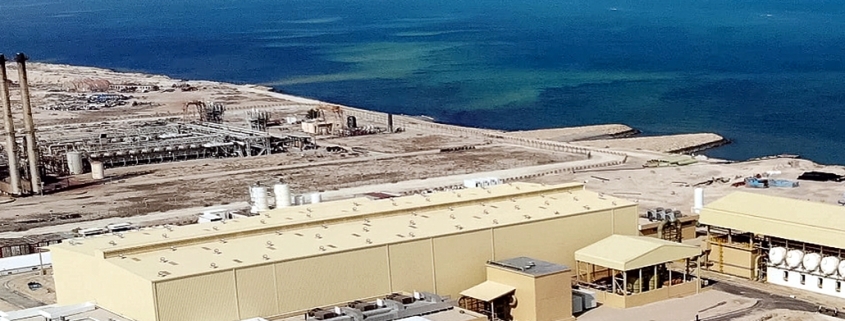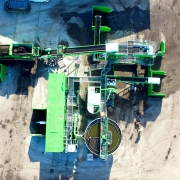Desalination Brine: Raw Materials in Deep Sleeping Beauty Sleep
Worldwide, 15,906 operational desalination plants turn fresh or brackish water into around 95 million cubic meters of desalinated water for human use and 142 million of brine daily. Although 177 nations feature such plants, only four nations – Saudi Arabia, the United Arab Emirates, Kuwait and Qatar – produce 55 percent of global desalination waste.
Desalination plants are traditionally accessed to two different types of technology. During the thermal process – mostly in Multi-Stage-Flash plants for evaporation –, the saltwater is repeatedly boiled and condensed. That is a method especially successful in removing salt, but requires lots of energy and turns 75 percent of the water imported into warm, slightly saltier wastewater. The other treatment technique is reverse osmosis (RO) that pressures saltwater through a semi-permeable membrane to keep back the salt. The remaining brine is around 50 percent saltier than the feed water but is not heated. Besides that, RO is cheaper and more efficient, as the technology requires less pressure and therefore energy. And the processing results in fifty percent freshwater and fifty percent brine. According to international water treatment company Lenntech, meanwhile, two-thirds of desalination plants resort to membrane processes. Today, Reverse Osmosis facilities account for 63 percent of the total desalination operations, followed by 23 percent of Multi-Stage Flash plants, eight percent of Multi-Effect Distillation, and some Electrodialysis or Electrodialysis Reversal facilities.
Treatment for disposal
The more or less voluminous resulting by-product is called brine, concentrate or reject. It may be either recycled for use in the facility’s process or treated for disposal. If water, heat, salt, or easily recyclable components of the brine cannot be used, it must be prepared for disposal. Samco Water Technologies suggests a treatment system consisting of membrane filtration – usually starting with ultrafiltration and ending with reverse osmosis –, evaporation of excess water to dry solids, crystallization of all the leftover impurities to filter them out as a solid, and the utilization of an ion exchange (IX) system to separate ionic contaminants. The purified brine can then be treated by membrane filtration, precipitation, carbon adsorption of organics, oil and water separation, precipitation for metals and ion exchange polishing. For this separation technology for purified brine – calculated for a system of 100 gallons per minute – about 750,000 to 2,500,000 US-Dollar must be invested. The ion exchange is figured at one to 1.5 million US-Dollar. And further treatment like crystallization might cost another 10 to 20 million US-Dollar, not to mention the operating and energy costs.
Huge disposal investment
For the disposal of brine, several options exist. According to the Lenntech website, the most common conventional processes in the USA are surface water discharge (45 percent), sewer disposal (27 percent), deep-well injection (13 percent), land application (8 percent) and evaporation ponds (4 percent). But even if the environmental impacts of these versions are not priced in, their construction costs for the disposal of theoretical 40,000 cubic meters per day – depending on the recovery rate – are huge, the Lenntech website clarifies: The discharge to seawater, lakes, rivers or other bodies of surface water totals up to 6.5 – 30 million US-Dollar; directing it to a publicly owned treatment work or sewer means 1.5 – 6 million US-Dollar; injecting brine into deep wells like porous rock formation underground needs 5 – 25 million US-Dollar; ponds for evaporation amount to 140 – 180 million US-Dollar; and “land application” – another word for spray irrigation – devours 30 – 40 million US-Dollar.
Number of technologies growing
If recycled, brines may be functional for further use like industrial cooling or deicing and acid or caustic production. According to Samco, the material can be “recycled and reused” in hydrometallurgical processing, applied in the generation of sodium hypochlorite or lithium carbonate, and in chlor-alkali manufacturing plants. There is a treatment method to prepare the concentrate for industrial use. Other methods were developed to lower the processing costs and the environmental impact of brine. There are some “common technologies” for brine treatment covering chemical precipitation, coagulation, electrocoagulation, oxidation-based technologies like ozonation and UV/H2O2 treatment, and – not very effective – biological processes. They are utilized to remove organics or organic compounds. New membrane-based technologies like forwarding osmosis, membrane crystallization and membrane distillation appear to be cost-effective methods. Meanwhile, several scientific publications like “Comparative study of brine management technologies for desalination plants” or “A review of the management and treatment of brine solutions” offer comprehensive comparisons on the plenty of processing methods. Some prefer osmosis, membrane distillation and electrodialysis as most promising for minimizing brine volume, others even deliver a comprehensive review of worldwide laboratory, pilot and industrial-scale experiments.
Brine – merely a residual?
It seems that nowadays brine has been interpreted as desalination residual from which some constituents may be useful. Brine is interpreted as a deliverer of secondary raw materials. Merely a scientific article in 2017 on “management and treatment of brine solutions” and an UN-backed paper, published by the UN University in January 2019, qualify its potential as “recovery of valuable resources”. Rightly, for brines are a composition of various elements compounds. An Arabian Golf Case Study explains that chlorine is added to the intake seawater to reduce biofouling, copper-nickel alloys are commonly used as heat exchanger materials, and ionized and unionized ammonia (NH3) species may occur. Another source states chloride (Cl-), sulfate (SO42-), potassium (K+), sodium (Na+), magnesium (Mg2+) and calcium (Ca2+) as the common components of brine. A comprehensive paper giving an “Overview on the treatment and management of the desalination brine solutions” indicates “multifarious contaminants” including “heavy metals, nutrients containing nitrogen and phosphorus [ammonia (NH3), nitrate (NO3 −), and phosphorus (K)] derivatives”. And Lenntech indicates the existence of calcium carbonate (CaCO3), calcium sulfate (CaSO4), barium sulfate (BaSO4), possibly calcium phosphate (Ca3(PO4)2) and – increasingly – antiscalants like polyphosphates, phosphonates or polycarbonic acids in brine. Regarding heavy metals appearance, lower quality stainless steel equipment leads to a higher concentration of iron, chromium, nickel and molybdenum, while lower-quality materials at the heat exchanger increase the copper and nickel concentrations.
Metals: Recovery of a valuable source
The UN University paper “The state of desalination and brine production: A global outlook” in January 2019 admitted that the desalination plant effluent is composed of a large number of salts and metallic ingredients including magnesium, gypsum, sodium chloride, calcium, potassium, chlorine, bromine and lithium. They would offer “economic opportunities to use brine in aquaculture, to irrigate salt-tolerant species, to generate electricity, and by recovering”. With better technology, a large number of salts and metals in the desalination plant effluent could be mined, notably even strontium, lithium, rubidium and uranium. That is why a detailed comparative study from 2014 explained that metal recovery is a provider of “new and plentiful sources of many valuable and scarce metals around the world” and judged its potential profitability “higher than any other technology”, suitable to “avoid the impact produced by mines or other extraction technology”. The Global Outlook-Paper followed this diction in 2019 and found metal recovery “a valuable source of many scarce metals”.
More attention needed
Anyway, the authors of the before mentioned “Overview”-article criticized in June 2020, that this technology to recycle metals “needs more attention and research to increase productivity and improve performance” and adequately more development “to be exploited on an industrial scale”. The research is on a laboratory or pilot scale, and it is difficult to determine the applicability on an industrial scale. That seems to be a drawback of every real brine material recovery. The high economic costs and energy demands of brine treatment and mineral recovery methods remain a significant barrier to a more widespread application, one can read in the UN University paper. Consequently, the official press release to this publication runs prosaic: “The needed technologies are immature. However, the recovery of these resources is economically uncompetitive today.”
Maybe the methods to recover the ingredients of brine are not yet marketable. But the interest for the issue is awakening. In February 2019, Massachusetts Institute of Technology published a study showing “that through a fairly simple process the waste material can be converted into useful chemicals – including ones that can make the desalination process itself more efficient”. It discussed direct electrosynthesis of sodium hydroxide (NaOH) and hydrochloric acid (HCl) from seawater desalination brine as an emerging alternative solution. At approximately the same time, the Red Sea Development Company (TRSDC) together with King Abdullah University of Science and Technology (KAUST) launched an international competition “challenging the world to find new solutions to protect marine habitats from brine discharge”. The Aquatech 2019 in Amsterdam featured a separate session on Water Nexus and Sustainable Brine Management and finalized it with the presentation of the competition’s best “Brains for Brine Challenge”. And estimations suggest there are already 40+ technology companies trying to enter the brine concentration market, on-line magazine Aquatechtrade.com gave account.
From problem to opportunity
Perhaps new technology can boost the development of resource recovery. In May 2019, a group of researchers at the Columbia University in New York developed a radically different desalination approach called “temperature swing solvent extraction” (TSSE) for hypersaline brines. The method found by Ngai Yin Yip, assistant professor at the university, works membrane-less and is not based on evaporative phase-change. It refers to a solvent with temperature-dependent water solubility. Added to the brine at room temperature, the solvent floats above the concentrate and detracts water from it. After a while, the solvent can be separated, drawn off and warmed up at 70° C. This temperature change forces the solvent to de-mixing from the water that settles down and gets collected. According to the university announcement, TSSE removed up to 98.4 percent of the salt, which is comparable to reverse osmosis, and a high-water recovery of more than 50 percent for the hypersaline brines, also comparable to current seawater desalination operations. This approach “has a clear path to commercialization” and might “be transformational for the water industry”. Perhaps it could even boost resource recycling from the dewatered and thereby concentrated brine.
Dr. Vladimir Smakhtin, a co-author of the paper from the UN University, is convinced of the progress: “The good news is that efforts have been made in recent years and, with continuing technology refinement and improving economic affordability, we see a positive and promising outlook.” And another co-author, Dr. Manzoor Qadir, is as well sure that “there is a need to translate such research and convert an environmental problem into an economic opportunity.”
(GR32020, Page 30, Photo: Siemens AG)








